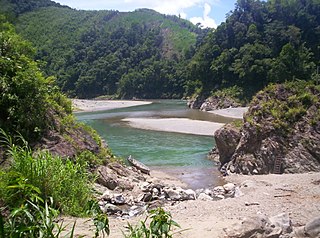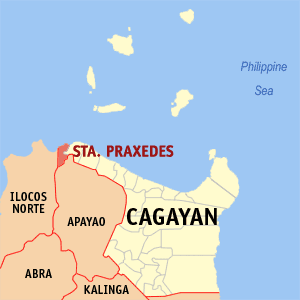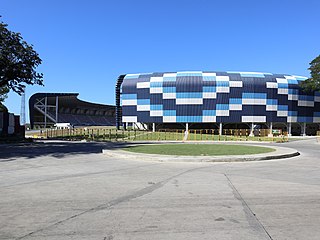
Nori(Japanese: 海苔) is a dried edible seaweed used in Japanese cuisine, usually made from species of the red algae genus Pyropia, including P. yezoensis and P. tenera. It has a strong and distinctive flavor, and is generally made into flat sheets and used to wrap rolls of sushi or onigiri.

Ilocos Sur, officially the Province of Ilocos Sur, is a province in the Philippines located in the Ilocos Region in Luzon. Located on the mouth of the Mestizo River is the capital of Vigan while Candon is the most-populous city. Ilocos Sur is bordered by Ilocos Norte and Abra to the north, Mountain Province to the east, La Union and Benguet to the south and the West Philippine Sea to the west.

Apayao, officially the Province of Apayao, is a landlocked province in the Philippines in the Cordillera Administrative Region in Luzon. Kabugao serves as its capital. The provincial capitol and its associated offices are located at the New Government Center in Luna.

Green laver, known as aonori in Japan, sea cabbage (海白菜) or hutai (滸苔) in China, and parae (파래) and kim (김) in Korean, is a type of edible green seaweed, including species from the genera Monostroma and Ulva. It is commercially cultivated in some bay areas in Japan, Korea, and Taiwan, such as Ise Bay. It is rich in minerals such as calcium, magnesium, lithium, vitamins, and amino acids such as methionine. It is also called aosa in some places in Japan.

Bangui, officially the Municipality of Bangui, is a municipality in the province of Ilocos Norte, Philippines. According to the 2020 census, it has a population of 15,019 people.

Marcos, officially the Municipality of Marcos, is a municipality in the province of Ilocos Norte, Philippines. According to the 2020 census, it has a population of 18,010.

Santa Praxedes, officially the Municipality of Santa Praxedes, is a municipality in the province of Cagayan, Philippines. According to the 2020 census, it has a population of 4,434 people, making it the least populated municipality in the province.

Laoag International Airport is an airport serving the general area of Laoag, the capital city of the province of Ilocos Norte in the Philippines. It is the only airport in Ilocos Norte and is the northernmost international airport in the Philippines.

Laverbread is a food product made from laver, an edible seaweed consumed mainly in Wales as part of local traditional cuisine. The seaweed is commonly found around the west coast of Great Britain, and the coasts of Ireland, where it is known as sleabhac. It is smooth in texture and forms delicate, sheetlike thalli, often clinging to rocks. The principal variety is Porphyra umbilicalis, a red algae which tends to be a brownish colour, but boils down to a dark green pulp when prepared. Laver seaweed has a high content of dietary minerals, particularly iodine and iron. The high iodine content gives the seaweed a distinctive flavour in common with olives and oysters.

Seaweed, or macroalgae, refers to thousands of species of macroscopic, multicellular, marine algae. The term includes some types of Rhodophyta (red), Phaeophyta (brown) and Chlorophyta (green) macroalgae. Seaweed species such as kelps provide essential nursery habitat for fisheries and other marine species and thus protect food sources; other species, such as planktonic algae, play a vital role in capturing carbon and producing at least 50% of Earth's oxygen.

Temptation Island is a 1980 Filipino film directed by Joey Gosiengfiao starring four beauty contest winners: Azenith Briones, Jennifer Cortez, Bambi Arambulo and Dina Bonnevie. Written by Toto Belano, the film is about a group of beauty contest finalists stranded in a desert island without food, water and shelter. It was re-released in 2008 at the Festival Paris Cinéma together with a retrospective on Gosiengfiao.

The MacArthur Highway, officially the Manila North Road, is a 685-kilometer (426 mi), two-to-six lane, national primary highway and tertiary highway in Luzon, Philippines, connecting Caloocan in Metro Manila to Aparri in Cagayan at the north. It is the second longest road in the Philippines, after the Pan-Philippine Highway. It is primarily known as MacArthur Highway in segments from Caloocan to Urdaneta, Pangasinan, although it is also applied up to Ilocos Sur and called Manila North Road for the entire length.

Edible seaweed, or sea vegetables, are seaweeds that can be eaten and used for culinary purposes. They typically contain high amounts of fiber. They may belong to one of several groups of multicellular algae: the red algae, green algae, and brown algae. Seaweeds are also harvested or cultivated for the extraction of polysaccharides such as alginate, agar and carrageenan, gelatinous substances collectively known as hydrocolloids or phycocolloids. Hydrocolloids have attained commercial significance, especially in food production as food additives. The food industry exploits the gelling, water-retention, emulsifying and other physical properties of these hydrocolloids.

Saint Augustine Parish Church, commonly known as Paoay Church, is a Roman Catholic church in the municipality of Paoay, Ilocos Norte in the Philippines. It is under the jurisdiction of the Diocese of Laoag. Completed in 1710, the church is famous for its distinctive architecture, a highlight of which is the enormous buttresses on the sides and back of the building. It is declared as a National Cultural Treasure by the Philippine government in 1973 and a UNESCO World Heritage Site under the collective group of Baroque Churches of the Philippines in 1993.

Caparispisan Wind Farm, also known as the North Luzon Renewables Wind Farm, is a wind farm in Pagudpud, Ilocos Norte, Philippines. The wind farm was a joint venture of AC Energy Holdings, the Philippine Alliance for Infrastructure and the UPC Philippines Wind Holdco. The wind farm project amounted to $220 million.

Matthew Joseph Marcos Manotoc is a Filipino politician and athlete from Ilocos Norte, Philippines. He is currently serving the second year of his second term as the governor of Ilocos Norte; he was a senior provincial board member from the second legislative district of Ilocos Norte from 2016 to 2019.

The Ferdinand E. Marcos Memorial Stadium, also known as Marcos Stadium, is a football and track stadium and park for sports and leisure in Laoag, Ilocos Norte.
The Pinto Underwater Sculpture Museum for Marine Ecosystem Regeneration is located in Currimao, Ilocos Norte's Poblacion Bay, in the Philippines.
Adelita Romualdo Bagcal is a Filipino chanter specializing in Dallot and other Ilocano oral tradition.


















